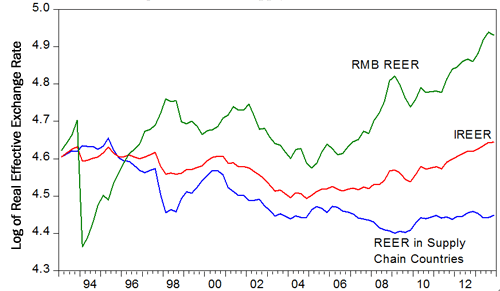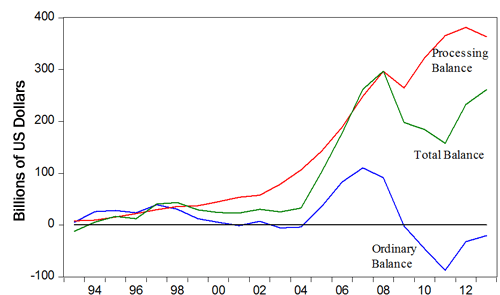| Author Name | THORBECKE, Willem (Senior Fellow, RIETI) |
|---|---|
| Research Project | East Asian Production Networks, Trade, Exchange Rates, and Global Imbalances |
| Download / Links |
This Non Technical Summary does not constitute part of the above-captioned Discussion Paper but has been prepared for the purpose of providing a bold outline of the paper, based on findings from the analysis for the paper and focusing primarily on their implications for policy. For details of the analysis, read the captioned Discussion Paper. Views expressed in this Non Technical Summary are solely those of the individual author(s), and do not necessarily represent the views of the Research Institute of Economy, Trade and Industry (RIETI).
International Macroeconomics (FY2011-FY2015)
East Asian Production Networks, Trade, Exchange Rates, and Global Imbalances
China's surplus in processing trade was close to $400 billion in 2012 and 2013. Between 2000 and 2013, its surpluses in processing trade cumulated to $3 trillion. Processing trade refers to a customs regime where exports such as tablet computers are assembled with parts and components such as microprocessors that are imported duty free. China's other major customs regime is ordinary trade. Ordinary exports are largely lower-end goods such as shoes and toys whose value added comes primarily from China.
For processed exports, on the other hand, much of the value added comes from sophisticated intermediate inputs produced in Taiwan, South Korea, and other parts of East Asia. Thus, exchange rates throughout the supply chain should influence processed exports.
This paper presents data of exchange rates throughout the supply chain relative to importing countries (IREER) for China's processed exports, which are graphed in Figure 1. The figure shows that, although the renminbi appreciated by 36% between 2005Q1 and 2013Q4, the IREER only appreciated by 14%. The reason for this is that the exchange rates in key supply chain countries have depreciated. This paper then estimates export functions for China's processed exports and reports that exchange rates throughout the supply chain affect China's processed exports.
Figure 1. The Integrated Real Effective Exchange Rate (IREER), the RMB REER, and the Weighted REER in Supply Chain Countries

Source: Bank for International Settlements, China Customs Statistics, International Monetary Fund International Financial Statistics, and calculations by the author.
For China's lower end ordinary exports, on the other hand, most of the value added comes from China. Thus, these exports depend primarily on the renminbi. If the renminbi appreciates alone without appreciations in supply chain economies such as South Korea and Taiwan, the price competitiveness of ordinary exports will be affected a lot but the price competitiveness of processed exports will be much less affected. This helps explain why, as Figure 2 shows, China's ordinary trade has been in deficit since 2009 while China's processed trade continues to exhibit large surpluses.
Figure 2. China's Ordinary, Processing, and Total Trade Balances

Source : China Customs Statistics.
To rebalance processing trade, exchange rate flexibility needs to take place, not at the country level, but at the level of the processing supply chain. If central banks in China and other surplus countries collectively reduced their rates of reserve accumulation and gave greater play to market forces, the surpluses that they run in processing trade and in their overall current account balances would generate a concerted appreciation of East Asian currencies against importers' currencies and help to rebalance processing trade.
Such an appreciation would have an attenuated effect on the export competition between East Asian economies in third countries because their currencies would be appreciating together. A joint appreciation would maintain intra-regional exchange rate stability and facilitate the flow of parts and components within production networks. It would also reduce the misallocation of resources that occurs when central banks sterilize the impact of reserve accumulation on domestic liquidity (see Yu, 2014). Finally, it would increase citizens' purchasing power and redirect final goods to Asia.

